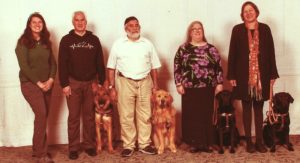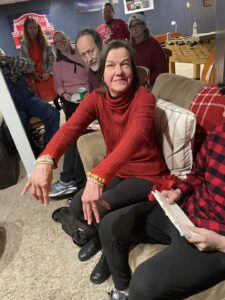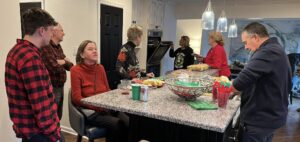Questions Kids Ask: Did Anything Scary Ever Happen to You?
January 28, 2024 • 5 Comments • Posted in Beth Finke, blindness, memoir writing, questions kids ask, Seeing Eye dogs, teaching memoir, visiting schools, writing, Writing for ChildrenTwo days ago our friend Ruth drove my Seeing Eye dog Luna and me to the Admiral At the Lake, a retirement community where I lead memoir-writing classes every Wednesday. I wasn’t there this time to lead a writing class, though: we were there to answer questions from third-graders who attend Goudy Elementary, a Public school for children of immigrants that is located near the Admiral in Chicago’s Uptown neighborhood.

My group’s graduation picture from the January class, 2020. I’m so lucky I got matched with Luna before the pandemic.
The third graders are part of a Friday “reading buddies” program at The Admiral, and on certain Fridays the third grade teachers and their students walk from Goudy Elementary to the Admiral so each third-grader can read out loud to an assigned Admiral resident, their “reading buddy.”
Luna and I were invited there last Friday because the third-graders had all read my children’s book “Safe & Sound” and they wanted to meet me. I gave a short presentation to explain how Luna had to go to the Seeing Eye School to learn to lead me around safely, and each child was encouraged to ask me a question when it was their turn.
Every single child told me their name, then introduced their question a la, “Hello, my name is Sunil, and here’s my question…”. I made a point to repeat each question so the Reading Buddies in the audience could hear them, too. Some examples:
-How do you know what you are wearing?
-How does your dog know where he’s going?
-Is there one place you go with your dog every day?
-Did any dog inspire Luna to help you?
-How do you lock the door?
-How do you come up with ideas of what to write?
-How old is your dog?
-How do you cook?
-How do you find the doorknob?
-How old are you?
-Did anything scary ever happen to you when you were with your dog?
-How do you grab things? How do you find them?
-You said you had five Seeing Eye dogs – which one is your favorite?
Dora, Hanni, Harper, Whitney…you’d think it’d be hard to choose, but for me this question is easy to answer. “Whichever dog is working with me right now is always my favorite,” I told them.
“So right now Luna is my favorite.”
The kids really were very, very well-behaved. The afternoon was delightful, everyone had a chance to participate and our interaction wasn’t limited to the most vocal in the group. Each one got a turn to ask their question.
Their reward? I took Luna’s harness off and invited them to pet her when it came time to head outside and walk back to Goudy Elementary. The Admiral had provided cookies for everyone, and the kids saw to it that our friend Ruth got a few on her way out. Everybody won!



